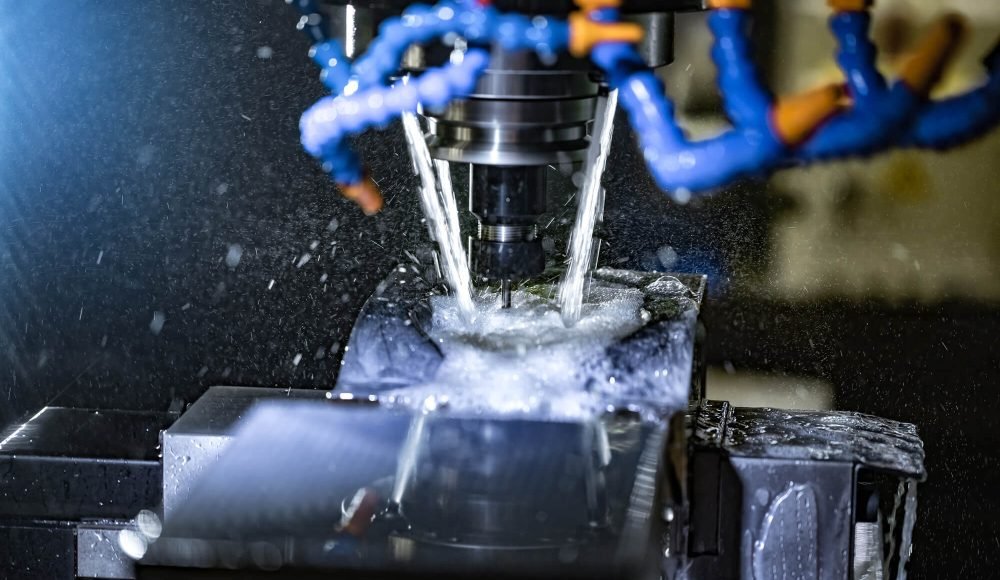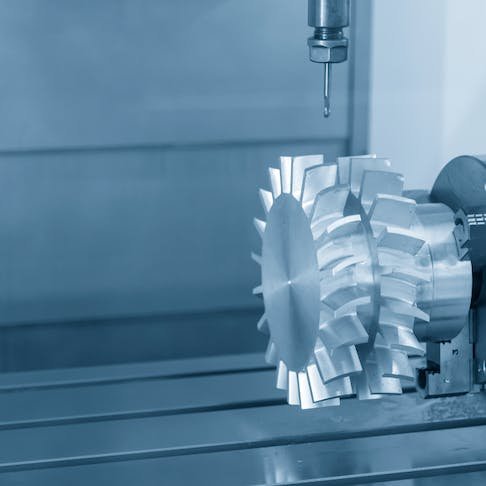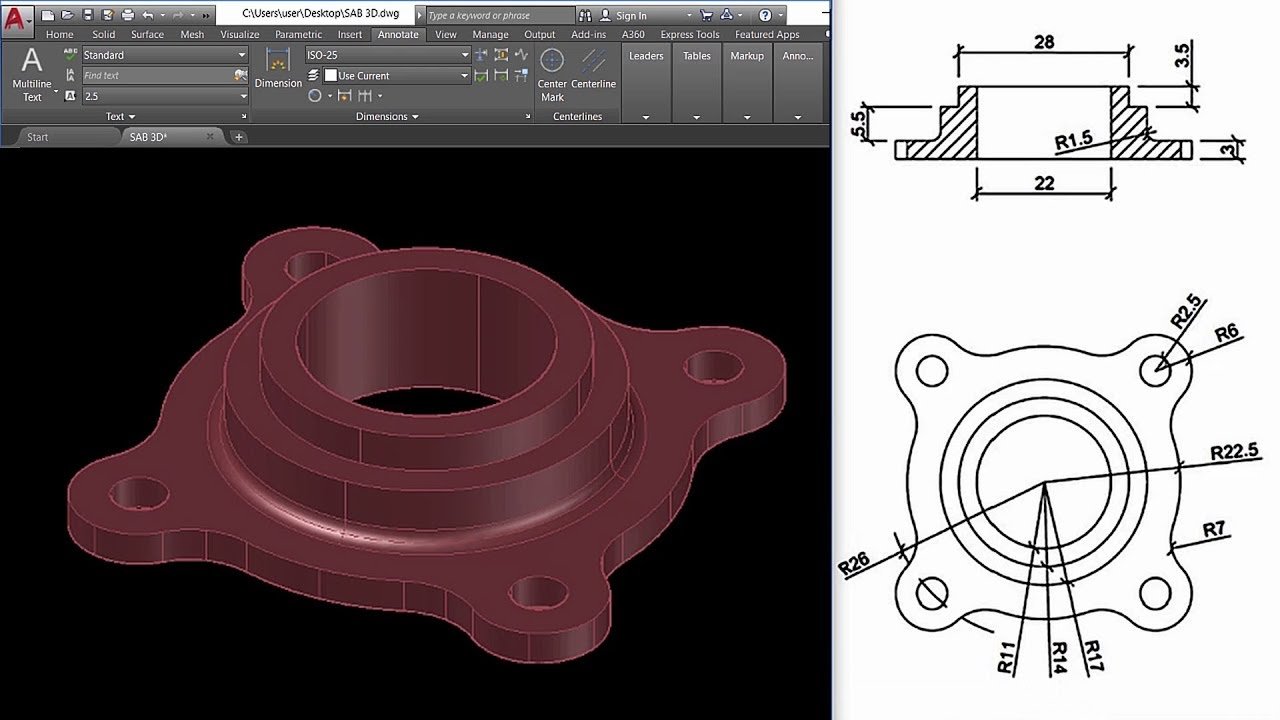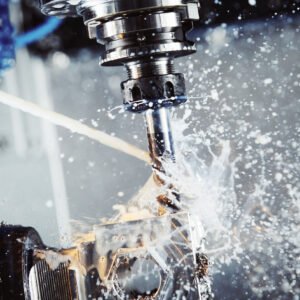3-usinage sur l'axe stands out as a fundamental process that has reshaped precision manufacturing. Que ce soit en aérospatial, automobile, médical, or electronics industries, this machining method plays a vital role in creating complex parts with high accuracy.
But what exactly is 3-axis machining? Comment ça marche? What are its advantages and limitations compared to more advanced technologies like 5-usinage sur l'axe? Dans ce guide complet, we’ll explore everything you need to know about 3-axis machining, from its basic principles to its real-world applications.
What is 3-Axis Machining?
À la base, 3-usinage sur l'axe is a manufacturing process where a cutting tool moves along three perpendicular axes—X (left and right), Oui (forward and backward), et Z (de haut en bas)—to shape a material. This method is commonly used in CNC (Commande numérique par ordinateur) usinage, where a computer automates the movement of the cutting tool to ensure precision.
Key Features of 3-Axis Machining
✔ Controlled Movement – The tool moves in three directions for efficient material removal.
✔ Coupure de précision – Ideal for creating detailed and accurate components.
✔ Automation with CNC – Reduces human error and increases production speed.
How 3-Axis Machining Differs from Other Methods
- Comparé à usinage manuel, 3-axis machining allows for higher precision and repeatability.
- Contrairement à 5-usinage sur l'axe, it does not rotate around additional angles, making it slightly less versatile but more cost-effective.
- Usinage multi-axe(such as 4-axis and 5-axis) provides additional flexibility for complex geometries, but at a higher cost.
3-axis machining remains one of the most widely used techniques in manufacturing due to its balance of affordability and precision.
How 3-Axis Machining Works
The 3-axis machining process consists of multiple steps, assurer un smooth workflow from raw material to finished product.
Étape 1: Programmation de la machine CNC
Before machining begins, un GOUJAT (Conception assistée par ordinateur) model of the part is created. This digital blueprint is then converted into CAME (Fabrication assistée par ordinateur) instructions, guiding the CNC machine.
Étape 2: Sécuriser la pièce
Le matériel (métal, plastique, bois, etc.) is firmly clamped to prevent movement during machining.
Étape 3: Cutting and Shaping the Material
Using rotating cutting tools such as drills, moulins, or end mills, the CNC machine removes excess material to achieve the desired shape.
Étape 4: Finishing and Quality Control
Une fois l'usinage terminé, finishing techniques comme polissage, ponçage, or coating are applied to enhance surface quality. The final part is inspected for accuracy and consistency.
This automated, step-by-step process ensures that every part meets strict quality standards, making 3-axis machining a preferred choice for precision manufacturing.
Types of Machines Used in 3-Axis Machining 🏭
3-Axis CNC Milling Machines 🏗️ – The Workhorse of Machining
Mieux pour: Coupe, mise en forme, and drilling solid materials like metal, plastique, et du bois.
- Comment ça marche:
UN rotating cutting tool moves along the X, Oui, et axes Z to remove material from a stationary workpiece. The cutting tool can create surfaces planes, machines à sous, et des trous, le faire the most common type of 3-axis machine. - Pourquoi c'est génial:
✔ Perfect for general machining
✔ Can handle a variety of materials(les métaux, plastiques, matériaux composites).
✔ High precision for industrial and commercial parts.
💡 Exemple: Si vous usinage pièces de moteur, metal brackets, ou des moules, a 3-axis milling machine is your best friend!
3-Axis CNC Machining Centers ⚙️ – More Features, More Power
Mieux pour: High-volume production of complex parts with multiple operations.
- Comment ça marche:
Similar to a fraiseuse, but with more automation and advanced features like tool changers, Systèmes de liquide de refroidissement, and faster cutting speeds. Cela fait great for large-scale production. - Pourquoi c'est génial:
✔ Reduces the need for manual intervention.
✔ Faster production = lower costs per part.
✔ Can perform multiple machining operations in one setup.
💡 Exemple: Utilisé dans automobile, aérospatial, et industries médicales for parts that require precision and repeatability.
3-Axis CNC Lathes 🌀 – The Best for Round Parts
Mieux pour: Turning cylindrical parts like shafts, tuyaux, et attaches.
- Comment ça marche:
Instead of a rotating cutting tool, un CNC lathe spins the workpiece while a stationary tool moves along the X and Z axes to shape it. Some models have a third axis for side milling or drilling. - Pourquoi c'est génial:
✔ produit perfectly round parts with haute précision.
✔ Faster than milling for objets cylindriques.
✔ Can handle matériaux durs comme le titane et l'acier inoxydable.
💡 Exemple: If you’re making engine pistons, des vis, or custom bolts, a 3-axis lathe is the way to go!
3-Axis CNC Routers 🏡 – Ideal for Wood, Plastique & Mousse
Mieux pour: Cutting softer materials like bois, acrylique, et de la mousse for furniture, signes, and decorative pieces.
- Comment ça marche:
UN high-speed rotating bit moves along three axes to tailler, couper, and shape materials. Contrairement aux fraiseuses, CNC routers are built for lighter materials and often have vacuum tables to hold down workpieces. - Pourquoi c'est génial:
✔ Cuts bois, plastique, et de la mousse avec speed and precision.
✔ Idéal pour fabrication de meubles, signalisation, et prototypage.
✔ Can create intricate designs and 3D carvings.
💡 Exemple: Used by cabinet makers, sign companies, and DIYers pour couper custom furniture, decorative panels, and artistic engravings.
3-Axis CNC Engraving Machines ✍️ – For Detailed Markings
Mieux pour: Engraving text, motifs, and intricate designs on métal, plastique, et du bois.
- Comment ça marche:
Uses a petit, high-speed cutting tool à etch or engrave designs onto a surface. Can be used for customized jewelry, trophies, plaques signalétiques, et l'image de marque. - Pourquoi c'est génial:
✔ Creates détails fins et precise markings.
✔ Perfect for logos, numéros de série, and personalized engraving.
✔ fonctionne sur métal, plastique, bois, Et même le verre.
💡 Exemple: If you need to engrave a company logo on metal tools or a custom name on a wooden plaque, this is the machine for the job!
3-Axis CNC Plasma Cutters 🔥 – The Heavy-Duty Cutter
Mieux pour: Cutting thick metal sheets with extreme speed and precision.
- Comment ça marche:
Uses a super-hot plasma torch to cut through metal by melting it. Contrairement aux fraiseuses, plasma cutters don’t remove material—they burn through it - Pourquoi c'est génial:
✔ Cuts acier, aluminium, and other thick metals avec facilité.
✔ Much faster than traditional sawing or shearing.
✔ Works well for industrial applications like shipbuilding and construction.
💡 Exemple: Utilisé dans automobile, fabrication de métaux, and industrial construction to quickly cut large sheets of metal.
Which 3-Axis Machine is Right for You? 🤔
| Type de machine | Mieux pour | Matériaux | Why Choose It? |
| Fraiseuse CNC | Usinage général, pièces plates, trous, machines à sous | Les métaux, plastiques, matériaux composites | Précis, polyvalent, largement utilisé |
| CNC Machining Center | Production à volume élevé, pièces complexes | Les métaux, plastiques, matériaux composites | Automatisé, efficace, multi-tasking |
| CNC Lathe | Parties cylindriques (arbres, boulons, anneau) | Les métaux (acier, aluminium, titane) | Haute précision, fast for round parts |
| Routeur CNC | Travail du bois, meubles, signalisation, prototypage | Bois, plastiques, mousse | Rapide, detailed carving & mise en forme |
| CNC Engraving Machine | Logos, texte, decorative engravings | Métal, bois, plastique | High detail, perfect for branding |
| CNC Plasma Cutter | Cutting thick metal sheets | Acier, aluminium, alliages | Heavy-duty, industrial use |
Applications of 3-Axis Machining
Due to its précision, efficacité, et rentable, 3-axis machining is widely used across multiple industries.
Industrie automobile 🚗
✔ Produces engine components, pièces de transmission, et les engrenages.
✔ Ensures high precision in car manufacturing.
Industrie aérospatiale ✈️
✔ Creates turbine blades, supports d'instruments, and structural aircraft parts.
✔ Requires extreme precision for safety and performance.
Medical Industry 🏥
✔ Used for making surgical tools, implants orthopédiques, et prothèses.
✔ Demands accuracy for medical applications.
Electronics Industry 📱
✔ Produces casings, cartes de circuits imprimées, and semiconductor components.
✔ Ensures miniaturization of high-tech devices.
Bijoux & Engraving Industry 💍
✔ Creates detailed, custom-designed jewelry pieces.
✔ Ideal for engraving logos, motifs, and inscriptions.
These diverse applications highlight the versatility of 3-axis machining in modern manufacturing.
The Benefits of 3-Axis Machining 🚀
Easy to Use & Widely Available 🏭
- Pourquoi ça compte: 3-axis machining is one of the most common CNC machining methods, so you don’t need to hunt for specialized equipment. Many machine shops already have these machines, ce qui signifie faster turnaround times and lower costs.
- What’s great about it?
✔ Simple programming compared to 5-axis machines.
✔ Easier for operators to learn and use.
✔ No need for ultra-complex software.
💡 Exemple: If you need a basic metal plate with holes or a simple bracket, a 3-axis machine can get it done quickly and affordably!
Cost-Effective 💰
- Pourquoi ça compte: 3-axis CNC machines are cheaper to buy, courir, et maintenir compared to more advanced 4- or 5-axis machines. This makes them a great option for businesses looking to keep costs low.
- What’s great about it?
✔ Lower machine costs mean cheaper parts for customers.
✔ Less setup time = production plus rapide et réduire les coûts de main-d'œuvre.
✔ Uses standard cutting tools, which are easy to replace.
💡 Exemple: If a company needs to produce hundreds of small, parties simples, 3-axis machining is an affordable and efficient choice.
Haute précision & Accuracy 🎯
- Pourquoi ça compte: Even though 3-axis machines are simpler than 5-axis machines, they can still produce extremely precise and accurate
- What’s great about it?
✔ Can achieve tolerances as tight as ± 0,01 mm.
✔ Ensures repeatability—every part comes out exactement le même.
✔ fonctionne très bien pour surfaces planes, trous, and standard geometries.
💡 Exemple: If you’re making aerospace or medical parts, La précision est tout. A 3-axis machine can cut with pinpoint accuracy Pour assurer un ajustement parfait!
Faster Production Time ⏳
- Pourquoi ça compte: Because 3-axis machines are simple to program and operate, they can cut parts rapidement without long setup times.
- What’s great about it?
✔ Less waiting—faster cutting = more parts produced in less time.
✔ Efficient for bulk production of simple parts.
✔ Perfect for meeting tight deadlines.
💡 Exemple: A manufacturer making 100 metal brackets for an automotive company can machine them in a seule journée using a 3-axis CNC!
Works on a Wide Range of Materials 🏗️
- Pourquoi ça compte: 3-axis machining isn’t limited to just metal—it can cut plastiques, bois, matériaux composites, et plus.
- What’s great about it?
✔ fonctionne sur acier, aluminium, laiton, et titane.
✔ Can also machine plastics like acrylic, polycarbonate, et du nylon.
✔ Even great for woodworking and foam cutting.
💡 Exemple: Si vous êtes milling a metal automotive part or cutting a wooden sign, a 3-axis machine can handle the job!
Ideal for Prototyping & Small-Batch Production 🏎️
- Pourquoi ça compte: Need to test a new product design? 3-axis machining is perfect for making prototypes before committing to full-scale production.
- What’s great about it?
✔ Quick and low-cost prototyping.
✔ Easy to tweak designs and make adjustments.
✔ No need for expensive setup costs.
💡 Exemple: A startup designing a new smartwatch case can machine a few prototypes in aluminum before deciding on the final design.
À faible entretien & Long-Lasting Machines 🛠️
- Pourquoi ça compte: Unlike high-end 5-axis machines, 3-axis machines are easier to maintain et durer plus longtemps because they have fewer moving parts.
- What’s great about it?
✔ Less risk of mechanical failure.
✔ Lower repair costs compared to advanced CNC machines.
✔ Machines can last years or even decades with proper care.
💡 Exemple: A well-maintained 3-axis milling machine can keep running for 10+ années, making it a great long-term investment!
Great for Simple to Moderately Complex Parts ⚙️
- Pourquoi ça compte: Not every project needs a super-advanced 5-axis machine. If your design is simple or moderately complex, a 3-axis machine gets the job done efficiently.
- What’s great about it?
✔ Perfect for pièces plates, trous, and standard shapes.
✔ Can create engrenages, assiettes, supports, and casings.
✔ Idéal pour 90% of common machining tasks.
💡 Exemple: A factory producing enclos électroniques can efficiently machine hundreds of cases using a 3-axis setup.
Is 3-Axis Machining Right for You? 🤔
✅ Choose 3-axis machining if:
✔ Your part is flat or has simple shapes.
✔ You want a rentable solution.
✔ You need délais d'exécution rapides.
✔ Your materials include les métaux, plastiques, ou du bois.
❌ Consider 4-axis or 5-axis machining if:
🚫 Your part has complex curves or undercuts.
🚫 You need to machine from multiple angles without repositioning.
🚫 Your project requires extreme precision in complex geometries.
Challenges and Limitations of 3-Axis Machining 🚧
Limited to Simple Geometries
- What’s the issue?3-axis machining is great for flat parts, basic holes, and standard cuts, but when it comes to surfaces courbes, deep pockets, or undercuts, it struggles.
- Pourquoi? The cutting tool can only move in three straight directions (X, Oui, et Z), so it can’t reach angles or intricate features without flipping the part.
- Exemple: If you’re making a turbine blade or a sculpted component, a 3-axis machine won’t be able to cut all the features in one go—you’d need additional setups.
More Setups = More Work & Time ⏳
- What’s the issue? Since 3-axis machines can only cut from three directions, you often need to stop the machine, reposition the part, and restart the process plusieurs fois.
- Pourquoi? Each setup takes time, increases labor costs, and raises the risk of misalignment.
- Exemple: If you’re making a complex part with features on all sides, tu pourrais avoir besoin 3-4 different setups, each requiring precise positioning.
Not Ideal for Deep Cavities & Internal Cuts 🔍
- What’s the issue?3-axis machining has trouble cutting deep pockets or internal features because the tool moves in a straight path and can’t easily reach confined spaces.
- Pourquoi? The deeper the cavity, the longer the cutting tool needs to be, et longer tools can bend or vibrate, réduction de la précision.
- Exemple: If you’re making a mold with deep, détails complexes, a 3-axis machine may struggle to reach certain areas without special techniques.
Requires Skilled Operators & Programmers 🎓
- What’s the issue? Even though 3-axis machining is simpler than 5-axis machining, it still requires skilled operators to program the toolpaths, set up parts correctly, and ensure precision.
- Pourquoi? Mistakes in programming or setup can lead to wasted materials, incorrect cuts, and longer production times.
- Exemple: A poorly programmed 3-axis machine might cut too deep or miss critical features, ruining an expensive block of metal.
Less Efficient for High-Precision or Large-Scale Production 🏭
- What’s the issue? For industries that require ultra-high precision or mass production, 3-usinage sur l'axe isn’t always the fastest or most efficient choice.
- Pourquoi? Since it requires more setups and manual adjustments, il slows down production compared to advanced multi-axis machines.
- Exemple: In aerospace manufacturing, where every part must be exact, a 5-axis machine can do in one step what a 3-axis machine takes multiple steps to achieve.
Can Waste More Material & Increase Costs 💰
- What’s the issue? Because 3-axis machining requires multiple setups and extra cuts to reach certain areas, it often results in more material waste.
- Pourquoi? Extra cutting means more metal chips, and repositioning errors can lead to parts being scrapped.
- Exemple: If a part is slightly misaligned when repositioned, even by a fraction of a millimeter, the whole piece might need to be discarded.
Comparison of 3-Axis Machining vs. 5-Usinage des axes
| Fonctionnalité | 3-Usinage des axes 🛠️ | 5-Usinage des axes 🚀 |
| Mouvement | Moves along X, Oui, Z axes only | Moves along X, Oui, Z + rotates around A & B axes |
| Complexity of Parts | Mieux pour simple, pièces plates | Mieux pour complexe, multi-sided, and curved parts |
| Temps d'installation | May require multiple setups to cut different sides | Cuts from multiple angles in one setup, reducing repositioning |
| Précision | Bon standard tolerances | Higher accuracy, Idéal pour l'aérospatiale, médical, et pièces automobiles |
| Coût | Coût inférieur (machine + travail + entretien) | Coût plus élevé due to advanced machinery and programming |
| Vitesse | Faster for parties simples, but extra setup time needed | Faster for pièces complexes since it reduces manual repositioning |
| Best Used For | Flat components, basic holes, les poches, machines à sous | Aubes de turbines, implants médicaux, aérospatial & pièces automobiles |
| Programming Difficulty | Easier to program and operate | Nécessite skilled programmers, more complex software |
| Déchets de matériaux | More waste due to repositioning errors | Less waste, more efficient material usage |
| Industries Using It | Fabrication générale, construction, mold-making | Aérospatial, automobile, médical, high-end prototyping |
Lequel devez-vous choisir? 🤔
✅ Choose 3-Axis Machining if:
- Vous avez besoin plat, parties simples with straight cuts.
- You want a cost-effective option with fast turnaround.
- Your project doesn’t require cutting from multiple angles.
✅ Choose 5-Axis Machining if:
- Your design has formes complexes, courbes, or deep cavities.
- Vous avez besoin high precision with fewer errors.
- You want to reduce setup time and improve efficiency.
Future of 3-Axis Machining
Avec les progrès technologiques, 3-axis machining continues to evolve:
✔ IA & Apprentissage automatique – Enhancing precision and automation.
✔ Hybrid Machining – Combining CNC with 3D printing for better efficiency.
✔ Smart Factories – Internet of Things (IoT) integration for real-time monitoring.
As industries demand faster and more precise production, 3-axis machining will remain a key player in modern manufacturing.
Conclusion
3-axis machining is a cornerstone of modern manufacturing, offering precision, efficacité, and versatility across various industries. While it may not match the flexibility of 5-axis machining, its affordability and ease of use make it an invaluable tool for manufacturers worldwide.
Whether you’re in automobile, aérospatial, médical, or jewelry design, 3-axis machining delivers reliable results that keep production moving forward. 🚀
Liens externes recommandés (References & Dès la lecture)
Here are three reliable sources for more information on 3-axis machining and CNC technology:
1️⃣ Modern Machine Shop – CNC Machining Basics – A trusted source for updates, news, and innovations in CNC machining.
2️⃣ CNC Cookbook – Guide to 3-Axis vs. 5-Usinage des axes – A detailed resource explaining the differences between multi-axis machining processes.
3️⃣ Autodesk – CAD/CAM for CNC Machining – A great place to explore software tools used in CNC programming and manufacturing.







